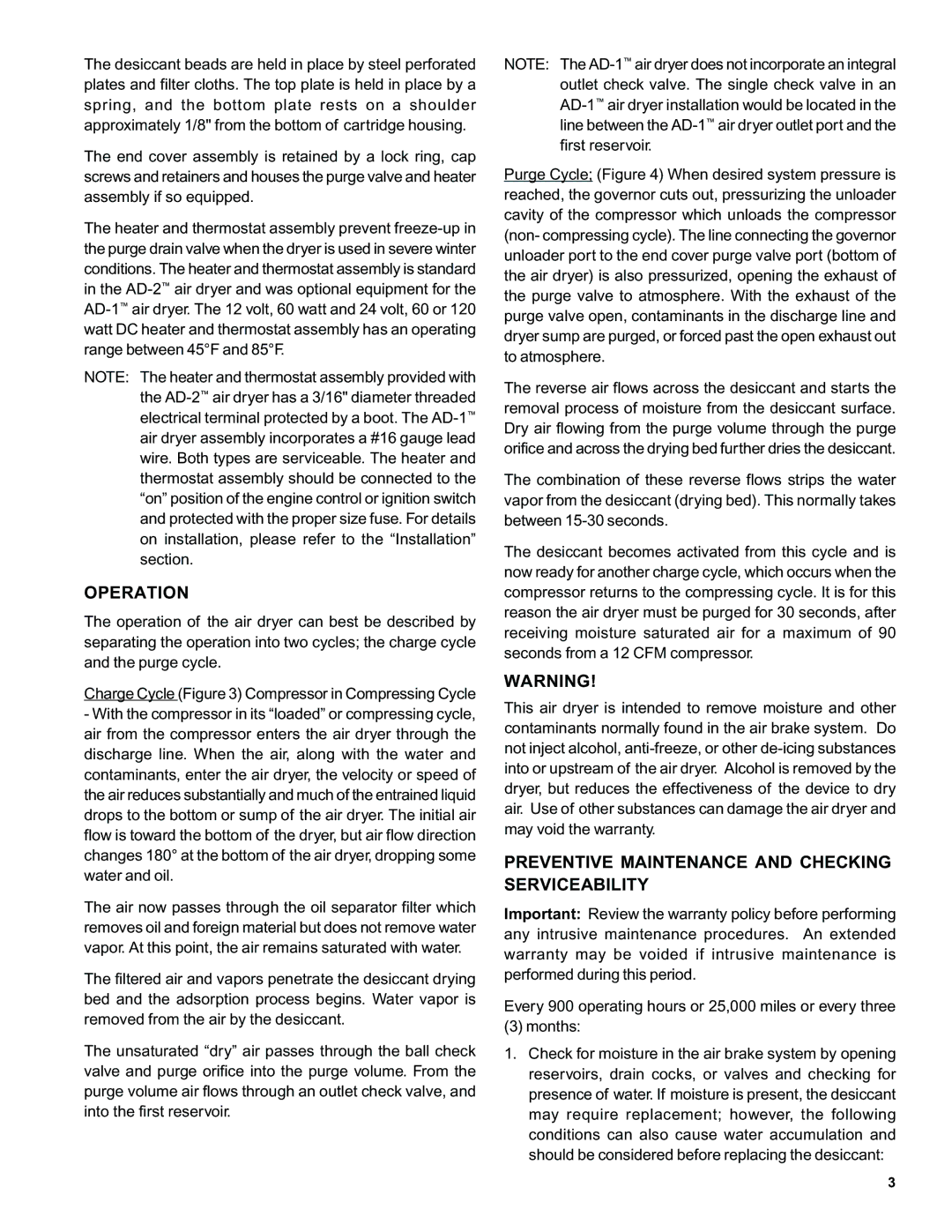The desiccant beads are held in place by steel perforated plates and filter cloths. The top plate is held in place by a spring, and the bottom plate rests on a shoulder approximately 1/8" from the bottom of cartridge housing.
The end cover assembly is retained by a lock ring, cap screws and retainers and houses the purge valve and heater assembly if so equipped.
The heater and thermostat assembly prevent
NOTE: The heater and thermostat assembly provided with the
OPERATION
The operation of the air dryer can best be described by separating the operation into two cycles; the charge cycle and the purge cycle.
Charge Cycle (Figure 3) Compressor in Compressing Cycle
-With the compressor in its “loaded” or compressing cycle, air from the compressor enters the air dryer through the discharge line. When the air, along with the water and contaminants, enter the air dryer, the velocity or speed of the air reduces substantially and much of the entrained liquid drops to the bottom or sump of the air dryer. The initial air flow is toward the bottom of the dryer, but air flow direction changes 180° at the bottom of the air dryer, dropping some water and oil.
The air now passes through the oil separator filter which removes oil and foreign material but does not remove water vapor. At this point, the air remains saturated with water.
The filtered air and vapors penetrate the desiccant drying bed and the adsorption process begins. Water vapor is removed from the air by the desiccant.
The unsaturated “dry” air passes through the ball check valve and purge orifice into the purge volume. From the purge volume air flows through an outlet check valve, and into the first reservoir.
NOTE: The
Purge Cycle; (Figure 4) When desired system pressure is reached, the governor cuts out, pressurizing the unloader cavity of the compressor which unloads the compressor (non- compressing cycle). The line connecting the governor unloader port to the end cover purge valve port (bottom of the air dryer) is also pressurized, opening the exhaust of the purge valve to atmosphere. With the exhaust of the purge valve open, contaminants in the discharge line and dryer sump are purged, or forced past the open exhaust out to atmosphere.
The reverse air flows across the desiccant and starts the removal process of moisture from the desiccant surface. Dry air flowing from the purge volume through the purge orifice and across the drying bed further dries the desiccant.
The combination of these reverse flows strips the water vapor from the desiccant (drying bed). This normally takes between
The desiccant becomes activated from this cycle and is now ready for another charge cycle, which occurs when the compressor returns to the compressing cycle. It is for this reason the air dryer must be purged for 30 seconds, after receiving moisture saturated air for a maximum of 90 seconds from a 12 CFM compressor.
WARNING!
This air dryer is intended to remove moisture and other contaminants normally found in the air brake system. Do not inject alcohol,
PREVENTIVE MAINTENANCE AND CHECKING SERVICEABILITY
Important: Review the warranty policy before performing any intrusive maintenance procedures. An extended warranty may be voided if intrusive maintenance is performed during this period.
Every 900 operating hours or 25,000 miles or every three
(3) months:
1.Check for moisture in the air brake system by opening reservoirs, drain cocks, or valves and checking for presence of water. If moisture is present, the desiccant may require replacement; however, the following conditions can also cause water accumulation and should be considered before replacing the desiccant:
3
